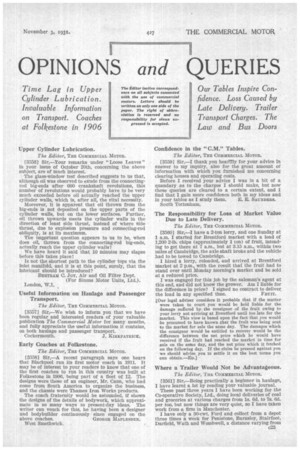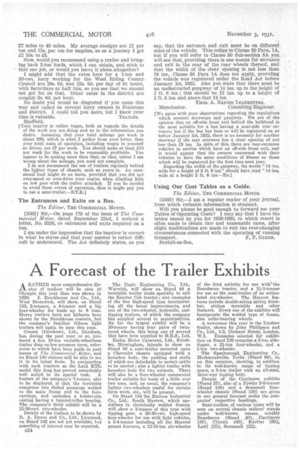OPINIONS and QUERIES Upper Cylinder Lubrication.
Page 157

Page 158

If you've noticed an error in this article please click here to report it so we can fix it.
The Editor, THE COMMERCIAL MOTOR.
[3556] Sir,—Your remarks under "Loose Leaves" in your issue of October 20th, concerning the above subject, are of much interest.
The glass-window test described suggests to us that, although oil was observed to exude from the connectingrod big-ends after 600 crankshaft revolutions, this number of revolutions would probably have to he very much exceeded before oil actually reached the upper cylinder walls, which is, after all, the vital necessity.
Moreover, it is apparent that oil thrown from the big-ends is not deposited on the upper parts of the cylinder walls, but on the lower surfaces. Further, oil thrown upwards meets the cylinder walls in the direction of least side thrust, instead of where side thrust, due to explosion pressure and connecting-rod obliquity, is at its maximum.
The imp,ortant question appears to us to be, when does oil, thrown from the connecting-rod big-ends, actually reach the upper cylinder walls?
We have heard it said that 10 minutes may elapse before this takes place !
Is not the shortest path to the cylinder tops via the inlet manifold, and it is at this point, surely, that the lubricant should be introduced?
BERTRAM C. JOY, Air and Oil Filter Dept. (For Simms Motor 'Units, Ltd.). London, W.1,
Useful Information on Haulage and Passenger Transport.
The Editor, THE COMMERCIAL MOTOR.
[35577] Sir,—We wish to inform you that we have been regular and interested readers of your valuable publication The Commercial Motor for many months, and fully appreciate the useful information it contains, on both haulage and passenger transport.
Cockermouth. J. KIRKPATRICE.
Early Coaches at Folkestone.
The Editor, THE COMMERCIAL MOTOR.
[3558] Sir,—A recent paragraph says one hears that Blackpool ran its first motor coach in 1911. It may be of interest to your readers to know that one of the first coaches to run in this country was built at Folkestone in 1906, being part of a fleet of 12. The designs were those of an engineer, Mr. Cann, who had come from South America to organize the business, and the chassis were Thames Iron Works products.
The coach fraternity would be astounded, if shown the designs of the details of bodywork, which approximate in so many ways to present-day ideas. The writer can vouch for this, he having been a designer and bodybuilder continuously since engaged on the
above coaches. GEORGE lifIAPLESDEN. West Smethwick. Confidence in the "C.M." Tables.
The Editor,. THE COMMERCIAL MOTOR,
[35591 Sir,—I thank you heartily for your advice in answer to my inquiry, also for the great amount of information with which you furnished me concerning clearing houses and operating costs.
Before I received your advice I was in a bit of a quandary as to the charges I should make, but now these queries are cleared to a certain extent, and I find that I gain more confidence both in ray ideas and
in your tables as I study them. E. E. SAUNDERS. South Tottenham.
The Responsibility for Loss of Market Value . Due to Late Delivery.
The Editor, THE COMMERCIAL MOTOR.
[35601 Sir,—I have a 2-ton lorry, and one Sunday at 1 a.m. I started for Brentford market with a load of 1,200 2-lb. chips (approximately 1 ton) of fruit, intending to get there at 7 a m., but at 315 a.m., within two miles of Cambridge, the axle shaft broke and the vehicle had to be towed to Cambridge.
I hired a lorry, reloaded, and arrived at Brentford market at 2 p.m. with the result that the fruit had to
stand over until p.m., morning's market and be sold at a reduced price.
I was engaged for this job by the saleman's agent at this end, and did not know the grower. Am I liable for the difference in price? I signed no contract to deliver
the load in any specified time. FRUIT.
[Our legal adviser considers it probable that if the matter were taken to court you would be held liable for the damage suffered by the consignor of the fruit owing to your lorry not arriving at Brentford until too late for the market. This view is based upon the fact that you would be presumed to have known that the fruit was being sent to the market for sale the same day. The damages which the consignor would be entitled to recover would be the differenee between the net price which he would have received if the fruit had reached the market in time for sale on the same day, and the net price which it fetched on the following day. If the claim be pressed against you we should advise you to settle it on the best terms you can obtain.—En.]
Where a Trailer Would Not be Advantageous.
The Editor, THE COMMERCIAL MOTOR.
[3561] Sir,—Being practically a beginner in haulage, I have learnt a lot by reading your valuable journal.
These past three years I have been working for the Co-operative Society, Ltd., doing local deliveries of coal and groceries at various charges from 1s. 6d. to 7s. 6d. per ton, but now things are very quiet, so I have taken work from a firm in Manchester.
I have only a 30-cwt. Ford and collect from a depot three times a week for Penistone, Barnsley, Stairfoot, Darfield, Wath and Wombwell, a distance varying from c23 .27 miles to 40 miles. My average receipts are fl per ton and 15s. per ton for empties, so on a journey I get £2 10s. to £3.
Now, would you recommend using a trailer and bringing back 3-ton loads, which I can obtain) and stick to that one job, or would you leave it alone. altogether?
I might add that the rates here for a 1-ton and 30-cwt. lorry working for the West Riding County , Council are 19s. 6d. -and 22s. dd. per day of 81 hours, with Saturdays at half this, so you see that we should not get fat on that. Other rates in the district are roughly 3s. 6d. per hour.
No doubt you would be disgusted if you came this way and called On several lorry owners in Penistone and district. I could tell you more, but I know your
time is valuable. TRAILER. Sheffield.
[Your inquiry is rather vague, both as regards the details of the work you are doing and as to the information you desire. Assuming that your total mileage per week is about 200, which is what I gather from your letter, then your total costs of operation, including wages to yourself as driver, are 17 per week. You should make at least k10 per week for the work to be reasonably profitable. You appear to be making more than that, so that, unlesa I am wrong about the mileage, you need not complain.
I do not recommend the use of trailers regularly behind the lighter types of 'chassis, such as yours is. An weesional. load might do no harm, provided that you did not over-speed or over-drive your engine when climbing hills on low gear with the trailer attached. If you be careful to avoid those errors of operation, then it might pay you to use a semi-trailer.—S.T.R.1
The Entrances and Exits on a Bus.
Tire Editor, THE COMMERCIAL MOTOR.
135621 Sir,—On page 179 of the issue of The Commercial Motor, dated September 22nd, I noticed a letter, No. 3526, re entrances and exits required on a bus.
I am under the impression that the inquirer Is correct • in what he states and that your answer is rather difficult to understand. The Act definitely states, as you
say, that the entrance and exit must be on different sides of the vehicle. This refers to Clause 30 Para. 1A, but if you will refer to Clause 30 Sub-section SA you will see that, providing there is one means for entrance and exit in the rear of the rear wheels thereof, and that the width of .the clear, opening is not less than 18 ins., Clause 30 Para 1A does not apply, providing the vehicle was registered under the Road Act before January 1st, 1032. Also you state that there must be an undbstructed gangway of 14 ins. up to the height of 2 ft. 6 ins.; this should be 12 ins, up to ;a height of 2 ft. 6 Ins, and above that 14 ins.
Taos. A. NAPIER LEADBETTER,
Manchester. Consulting Engineer.
[We agree with your observations regarding the regulations which concern doorways and gangway. We are of the opinion that an off-side front exit behind the bulkhead is the most suitable for a bus having a near-side rear entrance, but if the bus has been or will be registered on or before 2-anuary 1st, 1932, there is no necessity for another doorway if the rear entrance has a clear opening of not less than 18 ins. In spite of this, there are rear-entrance vehicles in service which have an off-side front exit, and it would appear that the owners concerned wish their vehicles to have the same conditions of fitness as those which will be registered for the first time next year. , Regarding the width of the gangway, the words " 14 ins. wide for a height of 2 ft. 6 ins." should have read "14 ins. wide at a height 2 ft. 6 ins.—End •
Using Our Cost Tables as a Guide.
The Editor, THE COMMERCIAL MoToR.
[35631 Sir,—I am a regular reader of your journal, from which valuable information is obtained.
Will you please be good enough to forward me your Tables of Operating Costs? I may say that I have the tables issued by you for 1929-1930, to which resort is often made to obtain fair and reasonable rates, after slight modifications are made to suit the ever-changing circumstances connected with the operating of running
transport. F. F. GREEN. Bexhill-on-Sea.








































































































































































































































